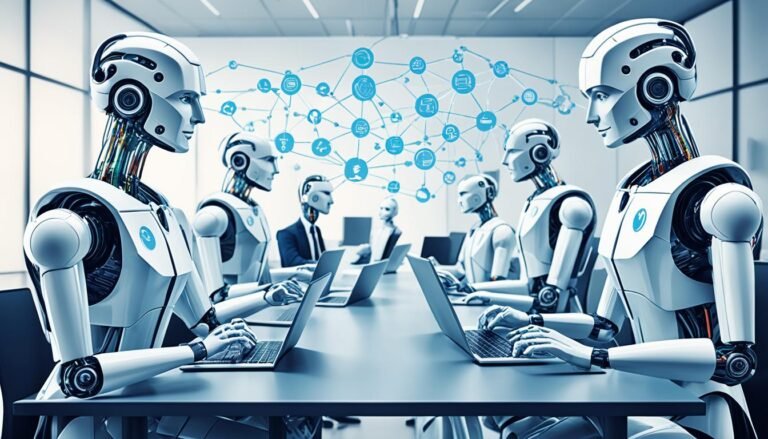Machine Learning 101: The Fundamentals of AI that Power Everyday Tech
Have you ever thought about how Netflix recommends the perfect show for you? Or how self-driving cars navigate busy streets safely? The magic behind these feats is machine learning – a key part of AI.
Machine learning is changing whole industries. It lets computers learn from data without someone directly telling them how. This ability is making our technology smarter and more useful every day.
Thanks to advanced algorithms, machine learning systems can spot data patterns and predict future outcomes. They do things like suggest movies we might like, filter out spam, or help autonomous vehicles drive on their own.
There are hurdles, like needing a lot of good data and tackling complex models. But the future looks bright. Machine learning and AI are set to keep on growing. They’ll touch more areas of our lives, like healthcare and finance.
Key Takeaways
- Machine learning is crucial in reshaping industries and revolutionizing everyday technology.
- It allows computers to improve performance on tasks over time without explicit programming.
- Various forms include supervised learning, unsupervised learning, and reinforcement learning.
- Applications range from movie recommendations to enabling self-driving cars.
- Challenges include the need for large datasets and understanding deep neural networks.
- The future of machine learning and AI promises significant technological advancements.
Introduction to Machine Learning and its Importance
Machine learning is a key part of artificial intelligence. It has changed how we use data, leading to new, powerful tech. Now, data can be analyzed and models built automatically, needing less human work. This makes it easier to use machine learning across many industries.
What is Machine Learning
Machine learning means analyzing data automatically. It can work with labeled or unlabeled data to find patterns. This power helps turn raw data into useful information, pushing tech forward in every field.
The Evolution of Machine Learning
Machine learning has come a long way since it began. It started with simple AI and now includes complex methods like deep learning. These steps have transformed areas such as computer vision and autonomous systems. They show how learning and improving models can change the world.
Why Machine Learning Matters
Machine learning is crucial for handling huge amounts of data and spotting important trends. It’s used in many fields like healthcare and finance. For example, it helps with disease diagnosis and fraud detection. Knowing about machine learning is key for future tech advancements.
“Machine learning has the potential to make previously unimaginable advancements, integrating itself deeply into the fabric of our daily lives.”
Understanding AI basics and data analysis is important for our tech future. By using automated model building, we can drive new tech, leading us into a smarter, data-focused future.
The Data Foundation: Fueling Machine Learning
The main ingredients for machine learning are top-notch data and strong algorithms. Data is key since algorithms learn from and enhance their performance with it. The world’s overflow of data drives the need for insights, boosting the machine learning field. Various algorithms, like supervised, unsupervised, and reinforcement learning, depend on data.
The Role of High-Quality Data
Algorithms excel with quality data. For example, in supervised learning, they use labeled data to spot patterns, which is vital for spotting fraud or predicting sales. The quality of data influences the precision of learning and the accuracy of results.
Types of Data
There are many kinds of data used in machine learning. Supervised learning needs labeled data for precise classification and pattern recognition, ensuring correct predictions. Unsupervised learning finds patterns in unlabeled data, like how Netflix suggests shows or Amazon suggests items for purchase. Reinforcement learning learns from feedback, getting better through rewards and penalties.
Data Collection, Cleaning, and Preparation
Collecting data is important, but not without cleaning and preparation. Data cleaning removes errors, maintaining data quality. Preparation converts raw data into a format suitable for learning. This process guarantees high-quality data, making machine learning applications effective.
Supervised Learning: Learning with Labels
Supervised learning is a key method within machine learning. It uses labeled data to let algorithms find patterns and links in the info provided. Well-organized labeled datasets are essential for training these algorithms effectively.
Concept of Labeled Data
Labeled data means each point has a marked output. This helps algorithms learn how to predict based on given info. In a spam filter, emails are marked as “spam” or “not spam.” This marking teaches the algorithm to make the right call, improving its work.
Supervised Learning Algorithms
Many different algorithms are part of supervised learning, each with its own strength. For example, linear regression predicts future prices by looking at past data. But decision trees are known for clear, easy-to-understand steps, good for things like spam filters.
Support vector machines are great for sorting data into different groups. They do this sorting after learning from labeled data. More learning means adjusting and refining the model for better results.
Use Cases of Supervised Learning
Supervised learning is used in many areas, like recognizing images. Algorithms learn to spot and classify objects in pictures. For making chatbots understand language (NLP), supervised learning helps teach them to respond correctly, depending on the conversation.
It also helps in suggesting items you might like, based on what you’ve liked before. In areas like translating languages or understanding sentiment, supervised learning does a great job. Yet, it relies heavily on having many and well-labeled data. Good labeling and enough data make the algorithms work better and more widely useful.
Unsupervised Learning: Discovering Hidden Patterns
Unsupervised learning is a key part of machine learning. It focuses on finding hidden patterns in data without labels. This helps us learn big things from raw, random data. It’s used in many areas because of this.
Techniques in Unsupervised Learning
Unsupervised learning uses smart ways to inspect data. It mainly uses clustering and dimensionality reduction. This lets it find patterns and structures without the need for names or labels.
Clustering
Clustering is a major player in unsupervised learning. It groups items that are alike, showing us natural groups in the data. It’s crucial in marketing, for instance. Here, companies can group customers based on what they buy.
Dimensionality Reduction
Dimensionality reduction is also important. It cuts down on how many data points we need while keeping the key bits. This not only makes things faster but also clearer. It’s great when working with big sets of data for better machine learning results.
Both clustering and dimensionality reduction are powerful tools in unsupervised learning. They help experts dig deeper into unmarked data, finding hidden gems. This way, they can make sense of a lot of information without labels.
Deep Learning: Unleashing the Power of Neural Networks
Deep learning is a new approach to machine learning using advanced neural networks. These networks have layers that work like the brain. This structure helps them work with a lot of data, learn from it, and make their own decisions.
Introduction to Neural Networks
Neural networks are the key to deep learning. They imitate how our brains work. These networks have layers of nodes or “neurons” that take in information, learn, and give out answers. As they learn, they improve their ability to recognize patterns. This improvement over time makes the networks fundamental to AI models.
Architecture and Training Process
Neural networks can take different shapes, including CNNs and RNNs. CNNs are great for seeing patterns in photos and videos. RNNs are best for understanding and predicting sequences, like in texting. To train these networks, they’re given lots of data to process. They learn to be better through processes like backpropagation and gradient descent.
Deep Learning Algorithms
Deep learning algorithms have changed machine learning. They do a great job with complex data. For example, CNNs are excellent for seeing objects in photos, and RNNs are strong at understanding languages. These algorithms have made a big difference in computer vision and understanding human languages. With new developments and more computing power, we can expect even more from AI.
Feature Engineering: The Art of Data Representation
Feature engineering is a key step in machine learning. It turns raw data into forms that algorithms can use well. This is vital for those creating models from data every day.
Feature scaling is a basic part of this. It puts all numbers into ranges that work well together. This makes the model work better. Creating new features based on what we know and thorough data study helps a lot. It ensures the data is spot on.
Creating new features is not the end. Handling missing data is also crucial. This includes using smart ways to fill in the gaps. Having clean, complete data is very important for models. It makes the whole process faster and easier.
Knowing how to get different types of data ready is also key. Things like changing numbers or making new categories help a lot. They make sure the model is as clear and accurate as possible.
“Effective feature engineering reduces computational and storage burdens, streamlines latency in training and predictions, and enhances model interpretability—a critical requirement in numerous applications.”
Data in the real world can be messy. Cleaning up and handling missing info matters a lot. Good quality data makes the model stronger and more reliable.
Even though there are tools that can do some things automatically, they can’t do it all. Human experts are still needed. They know the data and the problem better. This makes the model building process better and safer.
Mastering feature engineering is a big deal for data scientists. It helps turn raw data into powerful models. Models that can give deep insights. Getting the data right is the first and most important step on this road.
Reinforcement Learning: Learning Through Interaction
Reinforcement learning is an exciting part of machine learning. It focuses on making decisions through direct interaction. This happens in an environment, using a model to aim for certain goals via rewards and penalties.
Key Components of Reinforcement Learning
Reinforcement learning has key parts like Agent, Environment, State, Action, and Reward. The Agent takes Actions in the Environment. It moves between States based on the Reward system. This helps the Agent learn the best behaviors in different situations.
Figuring out the right mix of trying new things and sticking with what we know is crucial. Algorithms must learn when to try new strategies and when to use what they know. This balance of Exploration vs. Exploitation shapes how AI agents learn.
Popular Algorithms in Reinforcement Learning
There are different strategies to handle this balance. For example, the ε-greedy method involves mostly using known actions. But sometimes, with a small chance, it tries new things. The Upper Confidence Bound (UCB) strategy is also common. It finds the action with the highest potential reward based on certain calculations.
The Multi-Armed Bandit Problem shows the challenge of choosing between new and known options for the best results. Thompson Sampling offers a way to decide. It picks actions by sampling from a distribution of possible rewards, finding a good balance between new trials and sticking with what’s known.
Markov Decision Processes (MDPs) provide the base for modeling uncertain outcomes. They are key for many algorithms in reinforcement learning. With MDPs, algorithms can improve the AI agent’s actions over time.
In real life, reinforcement learning is making big changes. For instance, Amazon uses it for its robots in warehouses. Big tech companies like Google, IBM, Sony, and Microsoft are also investing a lot in this field. Even Facebook uses it to model human behavior. This shows how powerful reinforcement learning is in today’s tech world.
Applications of Machine Learning in Everyday Tech
Machine learning is changing how we live daily. It makes things work better and more tailored to our needs. For example, it helps businesses predict future trends, cameras recognize faces, and AI diagnose illnesses. This technology is now a big part of many tech tools we use every day, making things better all around. Let’s look at how it’s changing our world.
Predictive Analytics
Predictive analytics uses machines to look at past info and guess what will happen next. This is vital for businesses looking to the future, allowing them to spot trends, manage stock, and make shopping more personal. Amazon, for one, suggests items to shoppers based on what they’ve clicked or bought. The financial AI market is growing fast because of this, expected to be worth $9.45 billion by 2030.
Image Recognition
Image recognition is a big deal in today’s tech. It lets us open our phones with our faces and helps us find pictures easier. Big names like Google use this to tag who and what’s in a picture, making it a vaster online world. Plus, it’s a key part of security measures that keep us safer.
Medical Diagnosis
When it comes to health, machine learning is making big waves. It’s helping doctors spot diseases early on by looking at patient info from many sources. Now, these smart tools can detect serious illnesses like cancer and heart problems sooner, which means better care. This wider access to checkups also takes some pressure off healthcare workers.
Across the board, machine learning is shaping our future in tech, business, and health. Its use in our daily life makes things better and more advanced. Everywhere we look, it’s clear that machine learning is making a real difference.
Conclusion
We’ve journeyed through the world of machine learning. It’s clear that this tech is key to future AI. By focusing on supervised and unsupervised learning, we’ve learned how great data is vital. It fuels training processes to create models that predict accurately.
The importance of model evaluation and feature engineering was clear. They ensure our machine learning models are reliable. The use of deep learning, especially neural networks, is changing things. It’s making big waves in areas like computer vision.
Reinforcement learning is also making progress. This area helps algorithms learn to make good decisions over time. Inspiration from leaders like Mark Cuban and Satya Nadella is important. Their thoughts show us how advanced AI can be.
Looking ahead, we see exciting times in AI. Fields from healthcare to transportation are set to change. Responsible use of these technologies will lead us to a future where AI makes smart choices for us.
Source Links
- https://www.linkedin.com/pulse/machine-learning-101-understanding-fundamentals-ai-shuja-hafeez-kgkxc
- https://gitservices.com/ai-101-must-know-fundamentals-to-getting-started-in-artificial-intelligence/
- https://medium.com/@shinyrao6/machine-learning-101-understanding-the-fundamentals-of-ai-technology-f6aced69111b
- https://www.linkedin.com/pulse/machine-learning-101-understanding-fundamentals-ai-technology-v-il0ic
- https://medium.com/@manutej/a-non-technical-introduction-to-ai-part-1-a53471fae2fe
- https://www.ncbi.nlm.nih.gov/pmc/articles/PMC8633405/
- https://min2sleman.sch.id/2024/03/05/what-is-machine-learning-and-how-does-it-work-in/
- https://www.linkedin.com/pulse/machine-learning-101-understanding-fundamentals-ai-nagendra-chekuri-9rnbc
- https://dev.to/ulianaev/machine-learning-101-jb2
- https://datasciencedojo.com/blog/machine-learning-101/
- https://www.linkedin.com/pulse/machine-learning-101-understanding-fundamentals-ai-biswarup-pramanik-mgjic
- https://www.featureform.com/post/feature-engineering-guide
- https://medium.com/bitgrit-data-science-publication/feature-engineering-101-1360af860389
- https://dokumen.pub/the-art-of-feature-engineering-essentials-for-machine-learning-1nbsped-1108709389-9781108709385.html
- https://www.lakera.ai/blog/reinforcement-learning
- https://www.linkedin.com/pulse/machine-learning-101-understanding-fundamentals-ai-prasanth-pollai-tzrpc?trk=public_post
- https://www.slideshare.net/slideshow/the-unleashing-the-power-of-ai-how-machine-learning-is-revolutionizing-everyday-life/266979774
- https://www.linkedin.com/pulse/machine-learning-101-understanding-fundamentals-ai-technology-gupta
- https://medium.com/@omsrivastava295/machine-learning-101-understanding-the-fundamentals-of-ai-technology-2c057475c451?responsesOpen=true&sortBy=REVERSE_CHRON








